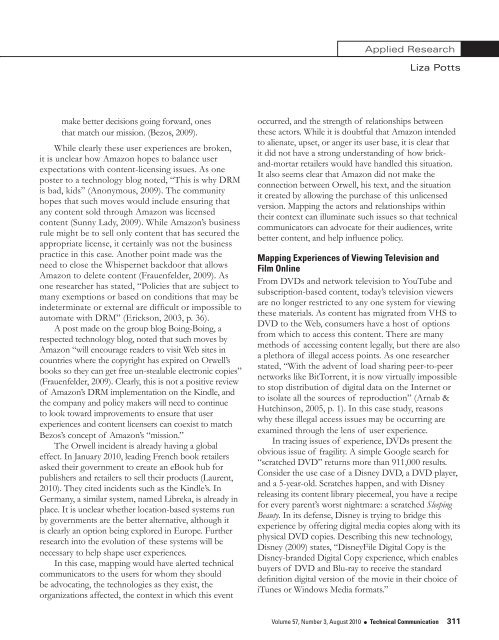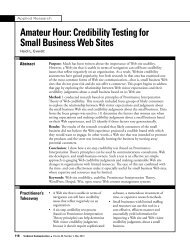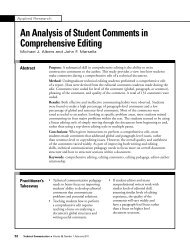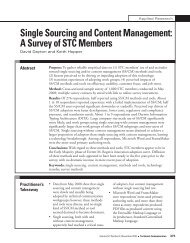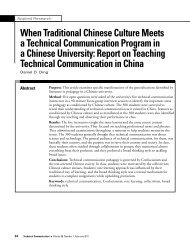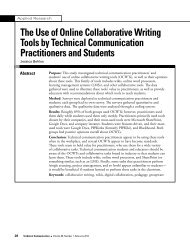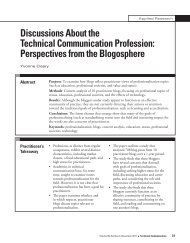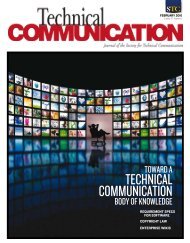Applied ResearchConsuming Digital Rightsare between 1984, Amazon.com, the Kindle device, andusers who own Kindles and 1984.While Amazon did issue refunds to the affectedconsumers, the company did not communicate thedeletion to them until after the content was removedthrough Whispernet. In particular, the removal of twoGeorge Orwell texts, 1984 and Animal Farm, that drewthe community’s ire. Users began posting to the Kindlecommunity forum on Amazon and elsewhere (KindleCommunity, 2009).Some of these users speculated that the removalof Orwell’s works was simply some sort of prank,alluding to the books’ topics of governmentalcontrol, lack of freedom, and dearth of privacy.One user noted, “Sounds ironically like Big Brotheris monitoring our Kindle content” (D. Parry, 2009).Another comment left on a technology-related blognoted that “if Amazon can delete books from yourKindle, presumably they can also replace those bookswith altered versions—to correct mistakes, deletedefamatory remarks, bowdlerize naughty bits or evenchange an author’s arguments if they or their corporatefriends didn’t agree with it. And you would neverknow” (Wetcoast, 2009).One user posted, “I wonder if Amazon will sendrepresentatives to customers’ houses to retrieve deadtree copies? Orwell fans, lock your doors!” (CaffeineQueen, 2009). The allusion to physical space wasnoted numerous times in this forum, with one userstating, “It’s like having Barnes & Noble sell youa book, charge your Visa and then 3 months laterchange their mind, credit your card and DEMANDtheir book be returned” (Ron in Richmond, 2009).This comparison between physical and virtual spacesis of interest because “enforcement of copyrightlaw has always been passive in the physical world”(Arnab & Hutchinson, 2005, p. 1). An even strongerstatement by one user relates feelings of violation andtheft of content by Amazon:This happened to me too. What ticked meoff is that I got a refund out of the blueand my book just disappeared out of myarchive. I emailed Amazon for an answeras to what was going on and they said therewas a “problem” with the book, nothingmore specific. I’m sorry, when you deletemy private property—refund or not—without my permission, I expect a betterexplanation than that. (Sunny Lady, 2009).These comments allude to consumer confusion andoutrage over current DRM practices. The same consumeradded, “I liken it to a B&N clerk coming to my housewhen I’m not home, taking a book I bought from thenfrom my bookshelf and leaving cash in its place. It’s aviolation of my property and this is a perfect exampleof why people (rightly) hate DRM” (Sunny Lady, 2009).Here, the notion of theft is confounded further bythe actual use of these systems, as consumers are notpurchasing a product—they are purchasing a license.As one researcher noted, “These technologies arenot really about the management of digital ‘rights’ butrather about management of certain ‘permissions’ todo X, Y, or Z with digital information” (Samuelson,2003, p. 42). In this case, the permission was to removecontent from consumers’ Kindles. However, thatpermission was not made explicit in the Kindle’s termsof service.On July 30, 2009, a class action suit was filedin the Western District of Washington (Case No.2:2009cv01084) in response to these removals. Thiscase, Gawronski v. Amazon.com, Inc., was settled onSeptember 25, 2009, providing compensation to thecustomers and mandating that Amazon adhere to itsterms of service.On September 3, 2009, Amazon offered to restorethe deleted content. Having secured the content licenses,the company was able to give customers legal copies ofthese works. In an apology posted to Amazon’s Kindlecommunity forums, CEO Jeff Bezos called the handlingof this event “stupid,” mentioning the criticisms thecompany received from consumers and consumeradvocates:This is an apology for the way we previouslyhandled illegally sold copies of 1984 andother novels on Kindle. Our “solution” tothe problem was stupid, thoughtless, andpainfully out of line with our principles. Itis wholly self-inflicted, and we deserve thecriticism we’ve received. We will use thescar tissue from this painful mistake to help310 Technical Communication l Volume 57, Number 3, August 2010
Applied ResearchLiza Pottsmake better decisions going forward, onesthat match our mission. (Bezos, 2009).While clearly these user experiences are broken,it is unclear how Amazon hopes to balance userexpectations with content-licensing issues. As oneposter to a technology blog noted, “This is why DRMis bad, kids” (Anonymous, 2009). The communityhopes that such moves would include ensuring thatany content sold through Amazon was licensedcontent (Sunny Lady, 2009). While Amazon’s businessrule might be to sell only content that has secured theappropriate license, it certainly was not the businesspractice in this case. Another point made was theneed to close the Whispernet backdoor that allowsAmazon to delete content (Frauenfelder, 2009). Asone researcher has stated, “Policies that are subject tomany exemptions or based on conditions that may beindeterminate or external are difficult or impossible toautomate with DRM” (Erickson, 2003, p. 36).A post made on the group blog Boing-Boing, arespected technology blog, noted that such moves byAmazon “will encourage readers to visit Web sites incountries where the copyright has expired on Orwell’sbooks so they can get free un-stealable electronic copies”(Frauenfelder, 2009). Clearly, this is not a positive reviewof Amazon’s DRM implementation on the Kindle, andthe company and policy makers will need to continueto look toward improvements to ensure that userexperiences and content licensers can coexist to matchBezos’s concept of Amazon’s “mission.”The Orwell incident is already having a globaleffect. In January 2010, leading French book retailersasked their government to create an eBook hub forpublishers and retailers to sell their products (Laurent,2010). They cited incidents such as the Kindle’s. InGermany, a similar system, named Libreka, is already inplace. It is unclear whether location-based systems runby governments are the better alternative, although itis clearly an option being explored in Europe. Furtherresearch into the evolution of these systems will benecessary to help shape user experiences.In this case, mapping would have alerted technicalcommunicators to the users for whom they shouldbe advocating, the technologies as they exist, theorganizations affected, the context in which this eventoccurred, and the strength of relationships betweenthese actors. While it is doubtful that Amazon intendedto alienate, upset, or anger its user base, it is clear thatit did not have a strong understanding of how brickand-mortarretailers would have handled this situation.It also seems clear that Amazon did not make theconnection between Orwell, his text, and the situationit created by allowing the purchase of this unlicensedversion. Mapping the actors and relationships withintheir context can illuminate such issues so that technicalcommunicators can advocate for their audiences, writebetter content, and help influence policy.Mapping Experiences of Viewing Television andFilm OnlineFrom DVDs and network television to YouTube andsubscription-based content, today’s television viewersare no longer restricted to any one system for viewingthese materials. As content has migrated from VHS toDVD to the Web, consumers have a host of optionsfrom which to access this content. There are manymethods of accessing content legally, but there are alsoa plethora of illegal access points. As one researcherstated, “With the advent of load sharing peer-to-peernetworks like BitTorrent, it is now virtually impossibleto stop distribution of digital data on the Internet orto isolate all the sources of reproduction” (Arnab &Hutchinson, 2005, p. 1). In this case study, reasonswhy these illegal access issues may be occurring areexamined through the lens of user experience.In tracing issues of experience, DVDs present theobvious issue of fragility. A simple Google search for“scratched DVD” returns more than 911,000 results.Consider the use case of a Disney DVD, a DVD player,and a 5-year-old. Scratches happen, and with Disneyreleasing its content library piecemeal, you have a recipefor every parent’s worst nightmare: a scratched SleepingBeauty. In its defense, Disney is trying to bridge thisexperience by offering digital media copies along with itsphysical DVD copies. Describing this new technology,Disney (2009) states, “DisneyFile Digital Copy is theDisney-branded Digital Copy experience, which enablesbuyers of DVD and Blu-ray to receive the standarddefinition digital version of the movie in their choice ofiTunes or Windows Media formats.”Volume 57, Number 3, August 2010 l Technical Communication 311
- Page 1 and 2:
AUGUST 2010Volume 57 Number 3SPECIA
- Page 3 and 4:
PresidentMichael A. HughesVice Pres
- Page 5 and 6:
VoLuME 57, NuMBER 3AUGUST 2010ISSN
- Page 7 and 8:
Guest EditorialKirk St.Amant and Ma
- Page 9 and 10:
Applied ResearchTechnical Communica
- Page 11 and 12:
Applied ResearchNicole St. Germaine
- Page 13 and 14:
Applied ResearchNicole St. Germaine
- Page 15 and 16:
Applied ResearchNicole St. Germaine
- Page 17 and 18: Applied ResearchNicole St. Germaine
- Page 19 and 20: Applied ResearchNicole St. Germaine
- Page 21 and 22: Applied ResearchNicole St. Germaine
- Page 23 and 24: Applied ResearchNicole St. Germaine
- Page 25 and 26: Applied TheoryTatiana BatovaIntrodu
- Page 27 and 28: Applied TheoryTatiana BatovaMoreno,
- Page 29 and 30: Applied TheoryTatiana BatovaThe Uni
- Page 31 and 32: Applied TheoryTatiana Batovadoctors
- Page 33 and 34: Applied TheoryTatiana BatovaTo addr
- Page 35 and 36: Applied TheoryTatiana Batovathe loc
- Page 37 and 38: Applied TheoryTatiana BatovaJohnson
- Page 39 and 40: Applied TheoryTatiana BatovaInterna
- Page 41 and 42: Applied TheoryMcKee and PorterIntro
- Page 43 and 44: Applied TheoryMcKee and PorterFor e
- Page 45 and 46: Applied TheoryMcKee and Porterpubli
- Page 47 and 48: Applied TheoryMcKee and PorterBecau
- Page 49 and 50: Applied TheoryMcKee and Porterof th
- Page 51 and 52: Applied TheoryMcKee and Porterwith
- Page 53 and 54: Applied TheoryMcKee and PorterA Cop
- Page 55 and 56: Applied TheoryMcKee and PorterConte
- Page 57 and 58: Applied TheoryMcKee and PorterWalto
- Page 59 and 60: Applied ResearchLiza PottsIntroduct
- Page 61 and 62: Applied ResearchLiza Pottsdoes not
- Page 63 and 64: Applied ResearchLiza PottsUser’s
- Page 65 and 66: Applied ResearchLiza Pottsactors, t
- Page 67: Applied ResearchLiza PottsDRM has a
- Page 71 and 72: Applied ResearchLiza PottsOne viewe
- Page 73 and 74: Applied ResearchLiza Pottsinvolved
- Page 75 and 76: Applied ResearchLiza PottsHayhoe, G
- Page 77 and 78: Applied ResearchInternational Fair
- Page 79 and 80: Applied ResearchTyAnna K. Herringto
- Page 81 and 82: Applied ResearchTyAnna K. Herringto
- Page 83 and 84: Applied ResearchTyAnna K. Herringto
- Page 85 and 86: Applied ResearchTyAnna K. Herringto
- Page 87 and 88: Applied ResearchTyAnna K. Herringto
- Page 89 and 90: Book ReviewsWriting Successful Scie
- Page 91 and 92: Book ReviewsThe Process: Business P
- Page 93 and 94: Book ReviewsHCI Beyond the GUI: Des
- Page 95 and 96: Book ReviewsOrigins of the Specious
- Page 97 and 98: Book Reviewsgenre, and process, top
- Page 99 and 100: Book ReviewsPart One goes from the
- Page 101 and 102: Book Reviewsrather than writers, an
- Page 103 and 104: Book ReviewsHow to Write Fast Under
- Page 105 and 106: Book Reviewsmanagement system (CMS)
- Page 107 and 108: Book Reviewsnearly strangled when h
- Page 109 and 110: Book Reviewsinteractive TV model)
- Page 111 and 112: Book ReviewsOtherwise, Beech shows
- Page 113 and 114: Book Reviewssuch as blog, I found m
- Page 115 and 116: Book Reviewsemployees and effective
- Page 117 and 118: Recent & RelevantSherry Southard, E
- Page 119 and 120:
Recent & RelevantRecent & RelevantC
- Page 121 and 122:
Recent & RelevantRecent & RelevantE
- Page 123 and 124:
Recent & Relevantworking in a langu
- Page 125 and 126:
Recent & RelevantWhat’s the big d
- Page 127 and 128:
Recent & RelevantScientific Writing
- Page 129 and 130:
Recent & Relevantapplicability. Man
- Page 131:
Did You Missthe Summit?Don’t miss


